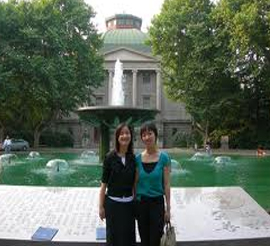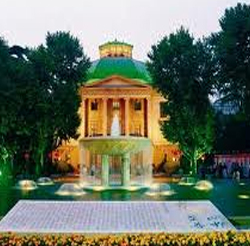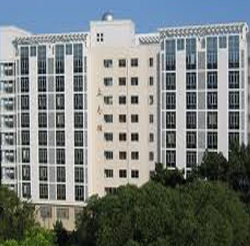
Southeast University(SEU) is one of the national key universities administered directly under the Ministry of Education of China. As a centennial prestigious university, it is located near the city center of Nanjing, to the west of the Purple Mountain and the south of Xuanwu Lake.
Southeast University is one of the oldest institutions of higher learning in China, whose origin can be traced back to 1902, when it was founded as Sanjiang Normal College. In 2000 Nanjing Railway Medical College (which is listed by WHO), Nanjing College of Communication and Nanjing Geological School were incorporateted into Southeast University.
Now Southeast University has developed into a comprehensive university, boasting over 40 schools or departments with 60 undergraduate disciplines in all. It also has 15 post-doctoral stations, and offers 105 PhD programs and 200 Master's programs; it holds a national lead in architecture, civil engineering, electronics, information technology, energy, power engineering, and transportation technology, etc.
Southeast University has the total number of faculty and staff of about 6000, including over 1500 professors and associate professors, 300 doctoral supervisors, 7 academicians of the Chinese Academy of Sciences and Academy of Engineering. At present, the number of the full-time students is over 26000, of whom about 9000 are postgraduates
Southeast University places equal emphasis on research. It is one of the top 10 universities in scientific research and development in China with over 20 national or provincial research institutes and a number of key research bases.
Southeast University, with the principle of pursuing perfection, encourages the spirit of "rigor, truthfulness, unity and diligence".
International cooperation & exchanges:
In the development of Southeast University, international cooperation & exchanges play an important role. Since 1978, more than 4000 teachers or researchers have been sent abroad for academic activities or exchanges, and over 3500 foreign experts and teachers have been invited to our university for lecturing, cooperative research or academic exchanges. Up to now, more than 2039 international students from 60 countries have studied in this university. We have signed agreements of cooperation with more than 100 universities, research institutes or corporations in the countries such as Australia, Britain, Canada, France, Germany, Italy, Japan, Korea, Vietnam, India, Singapore, Switzerland, Sweden and United States.
We have built a new campus in Jiangning, situated in the development zone of Jiangning district in the south part of Nanjing, covering the total area of more than 246 hectares, with convenient transportation and beautiful natural scenery around it. The new campus was put into use in Sept. 2006, providing our teachers and students with better facilities and accommodation.
Overview of Medical College, SEU
Medical College of Southeast University, originating from Nanjing Railway Medical College, whose origin can be traced back to the Medical College of the Central University founded in 1935, was merged to Southeast University in 2000. It enjoys its prestige home and abroad for its long history and high-quality education.
College of Medicine, Southeast University (SEU), is located by the scenic Xuanwu Lake in Nanjing, a historic and cultural city of China, bordering Hunan Street, a national famous business street. The campus boasts beautiful sceneries all around the year. The College of Medicine has been an important base in the national medical education. In the past years, it has cultivated more than 20,000 graduates, including some academicians of the Chinese Academy of Engineering and other many noted medical experts home and abroad.
College of Medicine, SEU is composed of School of Basic Medical Science, School of Clinical Medicine and School of Public Health. The College offers six Ph.D. programs, twenty-nine Master’s programs, one 7-year program for both Bachelor’s and Master’s degree and seven Bachelor’s programs. There are over 80 professors and 150 associate professors in the faculty of the College of Medicine, including 30 doctoral supervisors and 200 master’s supervisors, majority of whom have the experience of studying in famous foreign medical schools and have obtained Doctor’s degree. Additionally, there are 87 part-time professors and 226 associate professors in the attached hospitals and laboratory hospitals.
Infrastructure:
With 193,000 sq. m. of modern teaching and laboratory buildings, gymnasiums and libraries, College of Medicine, SEU covers the total area of 263,000 sq. m. The libraries collect 400,000 copies of books and 1500 kinds of foreign periodicals. The Clinical Experimental Center, which is under construction, will facilitate the medical students with modern clinical techniques, by means of the simulative electronic patient system. There are 19 hospitals attached to College of Medicine, SEU, more than 40 laboratory hospitals spreading across the country.
SEU is a comprehensive university with over 26000 full-time students, among whom 2700 are medical students consisting of 800 graduates and 1900 undergraduates. For years SEU has offered medical education programs for international medical students.
About Nanjing City:
Nanjing, known as Jinling in ancient China, is the capital of Jiangsu Province which lies on the lower reaches of the Yangtze River. The ancient city surrounded by mountains and the river was the capital of ten dynasties. A metropolis both ancient and modern, Nanjing has many places of interest, such as Sun Yat-sen Mausoleum, Ming Xiaoling Mausoleum, Mochou Lake, Qinhuai River, the Ming city wall, Zhonghua city tower, Zhanyuan Garden, Zijinshan Observatory, Tombs of the Southern Dynasties and the Yangtze River Bridge.
Being one of the four ancient capitals of China, Nanjing has always been a cultural center attracting intellectuals from all over the country. In the Tang and Song dynasties, Nanjing was a place where poets gathered and composed poems reminiscent of its luxurious past; during the Ming and Qing Dynasties, the city was the official imperial examination center for the Jiangnan region, again acting as a hub where different thoughts and opinions converged and thrived.
Today, with a long cultural tradition and strong support from local educational institutions, Nanjing is commonly viewed as a “city of culture” and one of the more pleasant cities to live in China.Nanjing has been the educational center in southern China for more than 1700 years. Currently, it boasts of some of the most prominent educational institutions in the region.
College of Medicine, Southeast University (SEU), is located by the scenic Xuanwu Lake in Nanjing, a historic and cultural city of China, bordering Hunan Street, a national famous business street. The campus boasts beautiful sceneries all around the year. The College of Medicine has been an important base in the national medical education. In the past years, it has cultivated more than 20,000 graduates, including some academicians of the Chinese Academy of Engineering and other many noted medical experts home and abroad.
Medical College of Southeast University, originating from Nanjing Railway Medical College, whose origin can be traced back to the Medical College of the Central University founded in 1935, was merged to Southeast University in 2000. It enjoys its prestige home and abroad for its long history and high-quality education.
College of Medicine, SEU is composed of School of Basic Medical Science, School of Clinical Medicine and School of Public Health. The College offers six Ph.D. programs, twenty-nine Master's programs, one 7-year program for both Bachelor's and Master's degree and seven Bachelor's programs.
There are over 80 professors and 150 associate professors in the faculty of the College of Medicine, including 30 doctoral supervisors and 200 master's supervisors, majority of whom have the experience of studying in famous foreign medical schools and have obtained Doctor's degree. Additionally, there are 87 part-time professors and 226 associate professors in the attached hospitals and laboratory hospitals.
With 193,000 sq. m. of modern teaching and laboratory buildings, gymnasiums and libraries, College of Medicine, SEU covers the total area of 263,000 sq. m. The libraries collect 400,000 copies of books and 1500 kinds of foreign periodicals. The Clinical Experimental Center, which is under construction, will facilitate the medical students with modern clinical techniques, by means of the simulative electronic patient system. There are 19 hospitals attached to College of Medicine, SEU, more than 40 laboratory hospitals spreading across the country.
Accommodation
SEU’s Int’l Students Dorms are scattered around Sipailou Campus, Dingjiaqiao Campus and Jiulong Lake Campus. Currently, most of the first-year students live at Jiulong Lake Campus; most of the medical students live at Dingjiaqiao Campus and the students of other majors live at Sipailou Campus. It takes 15 minutes to commute between Sipailou and Dingjiaqiao.
The room facilities in the 3 int’l students dorms are similar including air conditioning, water heater for shower, 2 beds/desks/chairs/cupboards, telephone, Internet access and bathroom. And self-supplied mini kitchens are available at the dorms at Sipailou and Dingjiaqiao campuses.
Rooms for new students shall be designated by CIS and application for change of rooms should be done one month after enrollment.
Why choose Southeast University (SEU)
Southeast University (SEU) is one of the national key universities administered directly under the Ministry of Education of China. As a centennial prestigious university, it is located near the city center of Nanjing, to the west of the Purple Mountain and the south of Xuanwu Lake.





